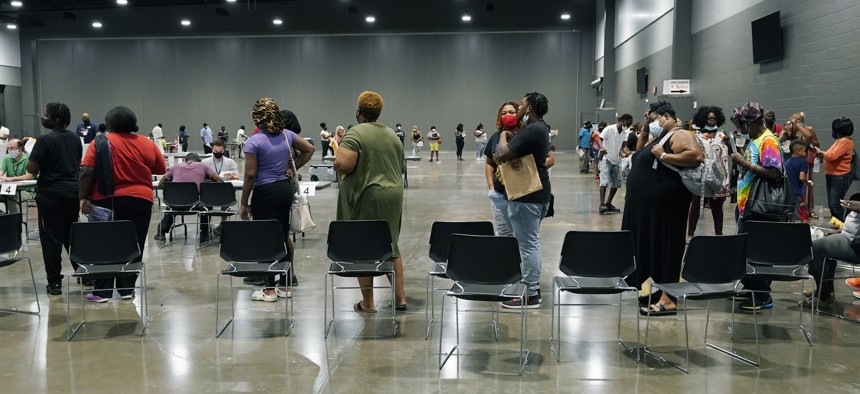Only 11% in Rental Assistance Spent, Treasury Department Prepares to Reallocate Unspent Aid

Applicants at a rental assistance fair for Jackson residents at the Mississippi Trademart, line up to be assigned the proper station in the state Fairgrounds, Saturday, July 24, 2021, in Jackson, Miss. AP Photo/Rogelio V. Solis
State and local rental assistance programs have doled out little of the $46.5 billion in emergency rental assistance and jurisdictions that don’t disperse money soon could have to return it.
Only 11% of the $46.5 billion in emergency rental aid authorized by Congress has been dispersed to tenants facing eviction, according to the latest data from the U.S. Treasury Department.
If state and local programs administering the rental assistance are not able to get money out the door to renters soon, they may lose out.
The Biden administration put grantees on notice through new guidance issued Wednesday that the Treasury Department is prepared to claw back unspent funds and reallocate the money to other jurisdictions. If grantees, including state and local governments, have not dispersed their first round of allocated funds by Sept. 30, the department is required to “recapture excess funds that have not been obligated … and reallocate those resources to high-performing jurisdictions that have obligated at least 65% of their original allocation.”
Congress approved $46.5 billion in emergency rental assistance to respond to the economic impact of the coronavirus pandemic, allocating two tranches of money in December and March. Only about $5 billion of the first tranche of funding has been spent, according to Treasury Department data detailing payments through the end of July. The pace at which money is being distributed to renters hasn’t drastically improved over the summer, even as the nationwide eviction moratorium expired and was replaced by a new moratorium that covers only some jurisdictions with high rates of coronavirus transmission.
In July, $1.7 billion was distributed to 341,000 households—a slight uptick from June, when $1.5 billion was distributed to 290,000 households. Close to 1 million households have received payments. That represents positive progress, said Diane Yentel, president and CEO of the National Low Income Housing Coalition.
“But the overall rate of spending emergency rental assistance remains much too slow,” she said in a statement.
“Some communities are spending the money quickly and well,” she said. “Seven months after funds were first allocated to them, nine states have spent less than 3% of the money and 16 states have spent less than 5%.”
Speeding Up the Pace
To speed up the pace at which struggling renters get their hands on the emergency assistance funds, the Treasury Department guidance released Wednesday includes recommendations meant to streamline the application process. The guidance clarifies that renters can self-attest to aspects of their rental assistance applications, such as their financial hardship, risk of homelessness or household income (when documentation is not available).
Documentation requirements have posed a significant barrier to faster application processing, according to the National Council of State Housing Agencies.
“We are pleased that Treasury is relaxing federal requirements that had slowed some emergency rental assistance program grantees’ delivery of funds,” said NCSHA Executive Director Stockton Williams. “The revised rules will enable state, local and tribal governments to further accelerate the delivery of much-needed rent relief.”
The guidance also indicates that state and local grant programs can provide advance bulk rental assistance payments to large landlords and utility providers based on an estimated amount of eligible debt. In addition, the guidance allows state and local programs to partner with nonprofits to provide assistance to renter households at risk of eviction while their applications are being processed.
While the Biden administration has chided state and local governments for not getting the money out faster, most government officials had to design emergency rental programs from scratch and it’s taken time for them to craft eligibility rules and find partner organizations to spread the word to tenants. Some programs also adopted more stringent rules than others, which has slowed down the process of vetting applicants and approving payments.
A dispute over the legality of the eviction moratorium could be headed back to the U.S. Supreme Court, and an adverse ruling could end the ban at any time—making the functionality of the rental assistance programs even more critical, Yentel said.
“There is little time and no excuse left—states, cities and counties must do more, better and faster to get rental assistance to tenants in need,” she said.
Andrea Noble is a staff correspondent with Route Fifty.
NEXT STORY: Survey: More than 40% of Employees Support Higher Insurance Rates for Unvaccinated





